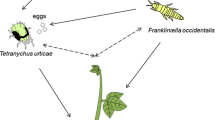Summary
The wolf spider Pardosa ramulosa is a dietary specialist on aquatic insects. Site tenacity of this species was determined by serological analysis of spiders collected on the margins of and at known distances from each of eight closely-spaced pools whose prey compositions were known. Remains of a mosquito species found uniquely in three of these pools were found only in spiders closely associated with them, despite the presence of otherwise suitable pools less than 10 m away. This indicates that spiders stay at specific pools for at least two weeks, the detectability period of this marker species in the assay.
The only exception to this site tenacity, except for inadvertant rafting during high tides, is the movement of adult females with egg cases away from pools. This is attributed to selection for avoidance of spiderling cannibalism, rather than a search for sunning or foraging sites as in some other lycosids.
The extreme site-tenacity of P. ramulosa is attributed to the high productivity of all pools, such that spiders from the most and least productive pools differ little if at all in fitness, and the high costs of moving to other pools, which are widely dispersed. The situation in crab spiders may be analogous. Conversely high and biologically significant variances in web site productivity, low distances between acceptable web sites, and low moving costs reduce site tenactiy in north temperate second growth orb weavers and a desert funnel web weaver.
Similar content being viewed by others
References
Breymeyer A (1966) Relations between wandering spiders and other epigeic predatory arthropoda. Ekol Polska 14:27–67
Comstock JH (1948) The spider book. Comstock, Ithaca
Edgar WD (1971) The life cycle, abundance, and seasonal movements of the wolf spider, Lycosa (Pardosa) lugubris, in central Scotland. J Anim Ecol 40:303–322
Garcia R, Schlinger EI (1972) Studies of spider predation on Aedes dorsalis (Meigen) in a salt marsh. Proc Paps, Fortieth Ann Conf Calif Mosq Contr Assoc 117–118
Greenstone MH (1976) A quantitative field study of predatory behavior in the wolf spider, Pardosa ramulosa. Ph. D. thesis, University of California, Berkeley, California
Greenstone MH (1976) A passive haemagglutination inhibition assay for the identification of stomach contents of invertebrate predators. J Appl Ecol 14:457–464
Greenstone MH (1978) The numerical response to prey availability of Pardosa ramulosa (McCook) (Araneae Lycosidae) and its relationship to the role of spiders in the balance of nature. Symp Zool Soc Lond 42:183–193
Greenstone MH (1979a) A line transect density index for wolf spiders (Pardosa spp.), and a note on the applicability of catch per unit effort methods to entomological studies. Ecol Entomol 4:23–29
Greenstone MH (1979b) Spider feeding behaviour optimises dietary essential amino acid composition. Nature 282:501–503
Greenstone MH (1980) Contiguous allotopy of Pardosa ramulosa and Pardosa tuoba (Araneae: Lycosidae) in the San Francisco Bay region, and its implications for patterns of resource partitioning in the genus. Amer Midl Nat 104:305–311
Greenstone MH (1982) Ballooning frequency and habitat predictability in two wolf spider species (Lycosidae: Pardosa). Fla Entomol 65:84–89
Greenstone MH, Bennett AF (1980) Foraging strategy and metabolic rate in spiders. Ecol 61:1255–1259
Hallander H (1967) Range and movements of the wolf spiders, Pardosa chelata and P. pullata. Oikos 18:360–364
Humphreys WF (1974) Behavioural thermoregulation in a wolf spider. Nature 251:502–503
Humphreys WF (1976) The population dynamics of an Australian wolf spider, Geolycosa godeffroyi (L. Koch 1865) (Araneae: Lycosidae). J Anim Ecol 45:59–80
Janetos AC (In Press) Foraging tactics of two guilds of web-spinning spiders. Behav Ecol Sociobiol
Kaston BJ (1972) How to know the spiders. 2nd Ed Wm C Brown, Dubuque, Iowa
Kronk AE, Riechert SE (1979) Parameters affecting the habitat choice of a desert wolf spider, Lycosa santrita Chamberlin and Ivie. J Arachnol 7:155–156
Kuenzler AE (1958) Niche relations of three species of lycosid spiders. Ecol 39:494–500
Lowrie DC (1973) The microbabitats of western wolf spiders of the genus Pardosa. Entomol News 84:103–116
McQueen DJ (1978) Field studies of growth, reproduction, and mortality in the burrowing wolf spider Geolycosa domifex (Hancock). Can J Zool 56:2037–2049
Morse DH, Fritz RS (1982) Experimental and observational studies of patch choice at different scales by the crab spider Misumena vatia. Ecol 63:172–182
Nørgaard E (1951) On the ecology of two lycosid spiders (Pirata piraticus and Lycosa pullata) from a Danish sphagnum bog. Oikos 3:1–21
Peck WB, Whitcomb WH (1978) The phenology and populations of ground surface, cursorial spiders in a forest and a pasture in the south central United States. Symp Zool Soc Lond 42:131–138
Readshaw JL (1973) The numerical response of predators to prey density. J Appl Ecol 10:342–351
Richter CJJ, den Hollander J, Vlijm L (1971) Differences in breeding and motility between Pardosa pullata (Clerck) and Pardosa prativaga (L Koch), (Lycosidae, Araneae) in relation to habitat. Oecologia (Berl) 6:318–327
Riechert SE (1974) The pattern of local web distribution in a desert spider: mechanisms and seasonal variation. J Anim Ecol 43:733–746
Riechert SE (1976) Web-site selection in a desert spider, Agelenopsis aperta (Gertsch). Oikos 27:311–315
Riechert SE, Tracy CR (1975) Thermal balance and prey availability: bases for a model relating web-site characteristics to spider reproductive success. Ecol 56:265–284
Siegel S (1956) Nonparametric statistics. McGraw Hill, New York
Uetz GW (1976) Gradient analysis of spider communities in a streamside forest. Oecologia (Berl) 22:373–385
Vlijm L, Richter CJJ (1966) Activity fluctuations of Pardosa lugubris (Walckenaer), Araneae, Lycosidae, during the breeding season. Ent Ber 26:222–230
Author information
Authors and Affiliations
Rights and permissions
About this article
Cite this article
Greenstone, M.H. Site-specificity and site tenacity in a wolf spider: A serological dietary analysis. Oecologia 56, 79–83 (1983). https://doi.org/10.1007/BF00378220
Received:
Issue Date:
DOI: https://doi.org/10.1007/BF00378220




